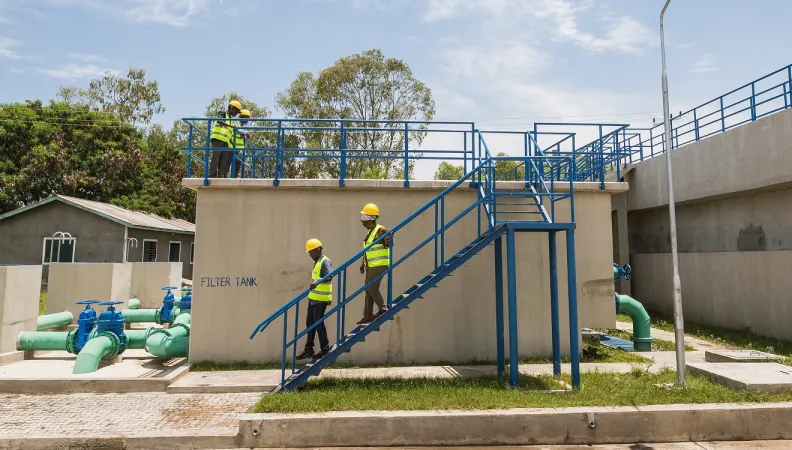Share the page
Summit on the Financing of African Economies: “The needs are enormous”
Published on

France is holding a summit on May 18 on the financing of African economies, most of which have suffered from the health crisis. In this interview, Cécile Valadier, AFD's Deputy Head of the Economic Assessment and Public Policy Department, takes stock of the economic situation in African countries and the solutions proposed by the international community to get their economies back on track.
What state are African economies in, a year and a half on from the start of the Covid-19 pandemic?
Cécile Valadier: Economic activity in Africa has been less affected than other regions of the world, such as Latin America. It nevertheless experienced a GDP decline of 1.9% on average in 2020. It’s the first time in at least 30 years that Africa has gone through a recession.
Some countries have been hit more severely than others by the health crisis. We can see this in the Comoros, the Gambia , and the Seychelles, which depend on tourism, and also in Angola, Nigeria, and the Congo, which have been affected by the drop in oil prices.
It’s also generally the case of countries dependent on raw material exports, such as South Africa, Zambia and others. The countries that have fared best are those that have diversified their revenues and managed to benefit from growth in sectors less affected by the crisis. These include Benin, Côte d’Ivoire, Kenya, and Senegal.
Overall, extreme poverty grew last year: sub-Saharan Africa now has 34 million “new poor” living on less than $2 a day, according to World Bank estimates.
How is economic recovery in Africa shaping up?
C.V.: The African economy is expected to pick up, with GDP growth estimated at up to 3.4% this year. It won’t be possible to return to pre-crisis levels for at least several years. The recovery in Africa is thus smaller than in the advanced economies of the rest of the world.
See also: “African Economies in 2021: reasons for optimism”
There are two reasons for this. First, the delay in obtaining vaccines is complicating a return to normal economic activity in African countries, because they will probably have to maintain some restrictions in the coming months. Second, African countries spend a smaller share of GDP on stimulus packages because they do not have the same fiscal resources as other economies. Their access to tax revenue and to external financing is limited, as is the room for maneuver of their central banks.
Is the public debt of African countries a cause of concern?
C.V.: It was a cause of concern even before the crisis! Many countries benefited from the debt cancellations of the 2000s, but there has been a marked trend toward re-indebtedness. The continent’s cumulative public debt, for example, rose from $650 billion in 2010 to $1.4 trillion in 2019. Nineteen countries are in a situation of over-indebtedness.
In 2020, debt as a percentage of GDP increased in 44 African countries. The health crisis is a shock with long-lasting consequences, and we can expect this substantial increase in debt to last for some time. Given the spending to combat the health crisis, debt will not go away on its own.
What worries us is that, for financing, the needs are enormous in these countries. It will be difficult for them to resort to external debt, particularly for social, education or infrastructure expenditures that are likely to boost growth. These issues are more fully developed in a research paper in the Macrodev series that we’ve just published in French on the current state and future challenges of debt sustainability in Africa.
What solutions are proposed by the international community?
C.V.: Bilateral lenders from the Paris Club realized early on that traditional external sources of funding would dry up, and that this would create tensions in financing the responses to the health crisis.
A number of debt repayments scheduled for 2020 were suspended, representing a total of €6 billion. That suspension was then extended to 2021. This has given governments breathing space, enabling them to use funds for pressing health and social expenditures. Work is now underway with members and non-members of the Paris Club to restructure the debt of several countries.
For its part, France, via AFD, launched the Health in Common initiative in April 2020, at the start of the crisis. Its aim is to support health systems in fragile countries, especially in Africa. This €1.2-billion initiative has already helped support domestic programs to respond to Covid-19 and to bolster regional networks for epidemiological surveillance.
France is hosting the Summit on the Financing of African Economies. What are the summit’s objectives?
C.V.: Heads of State from Africa and the G20 will meet together to push forward the financial responses that African countries need. It will be an opportunity to assess financing needs and to see how they can be met. The summit will also discuss the Common Framework for Debt Treatments. Implementation of this program for debtor countries in difficulty, announced last November by the G20, helps focus donor efforts on a strong and joint response.
A multilateral approach to these issues is possible and moreover desirable. It will help achieve better results by including more creditors. Afterwards we’ll have to see whether private creditors are prepared to make financial efforts at least as big as those of public lenders.
The summit will also discuss Africa’s economic recovery. How can Africa get back on the growth track? What players will be behind it in the African private sector? And what can lenders do to support this sector? It’s in this way that we’ll be able to alleviate the debt burden of African countries.
